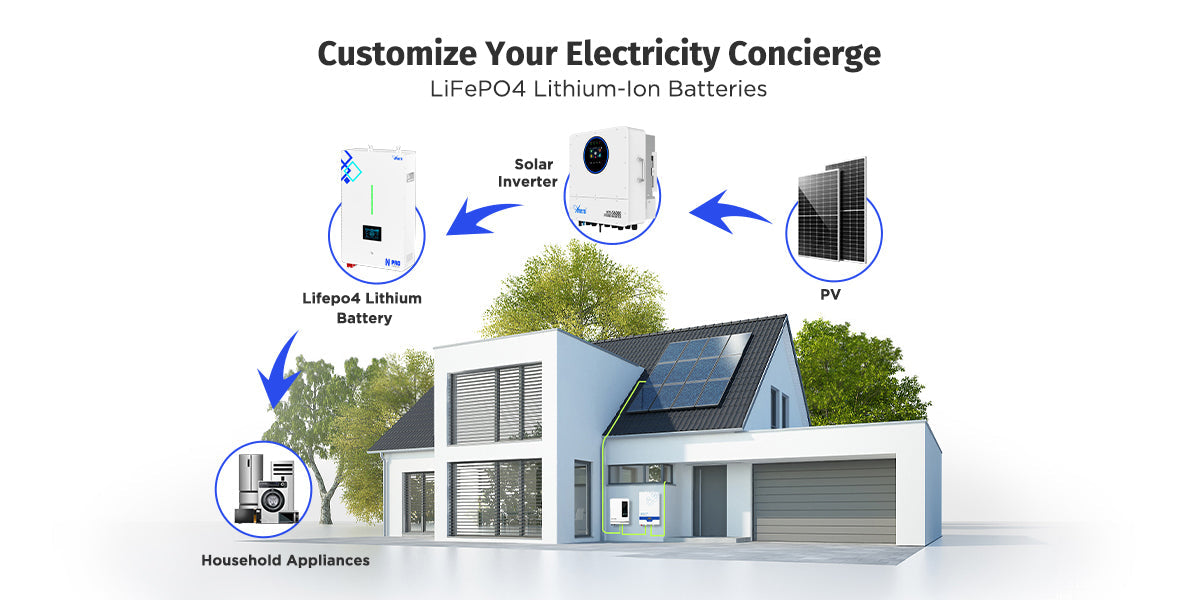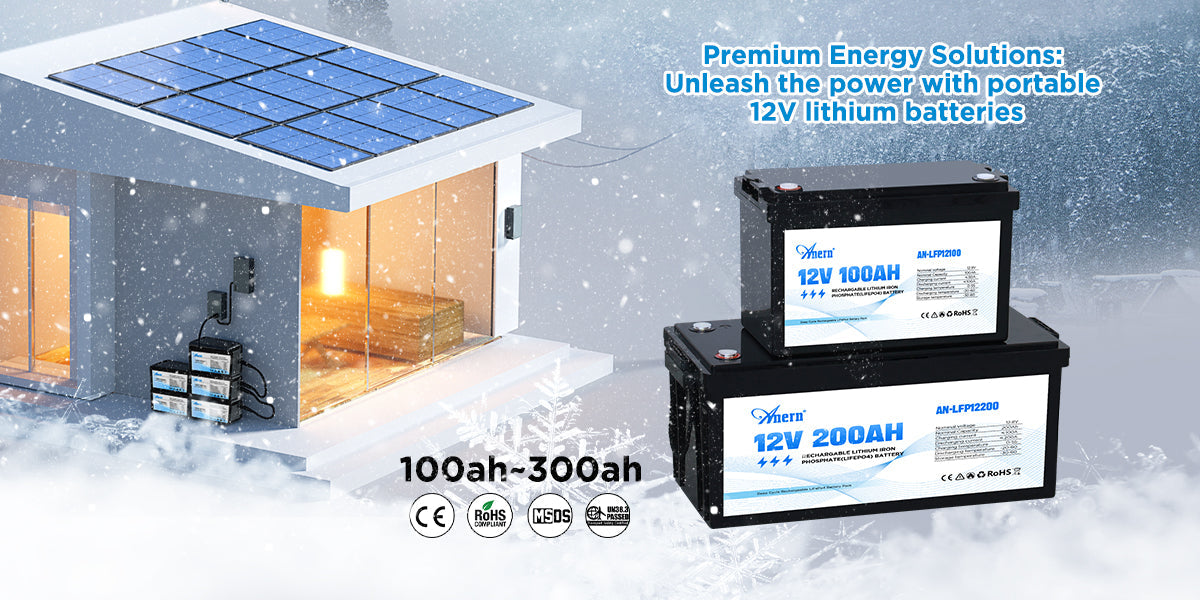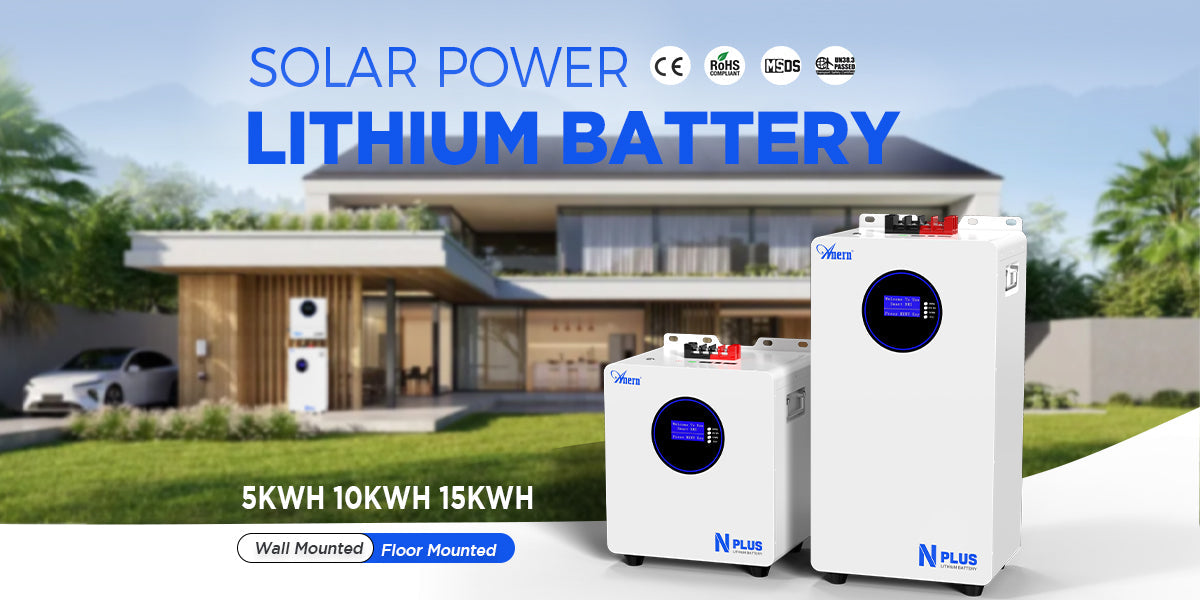Sizing a lithium ion solar battery should feel precise, not lucky. Oversized and budget sit in idle capacity. Undersized and lights dip at dinner, pumps stumble on start, and winter days fail to recharge. You need a path that holds up in real use.
This guide gives six inputs, one clear equation for kWh, two power checks for kW and surge, and a clean mapping to strings at 48 V. Follow it, and you turn daily kWh into a bank that carries evening peaks, cold snaps, and busy shifts.
What Data Do You Need to Size a Lithium Ion Solar Battery?
A solid result starts with the right inputs. Capture them once, then reuse for every check.
| Input (US units) | Example | Why It Matters |
| Daily energy use | 12 kWh | Sets the battery energy target |
| Peak running power | 5 kW | Validates continuous output |
| Highest start surge | 10 kW or 120 A | Screens short bursts from motors |
| Days of autonomy | 1 day | Defines backup depth for off-grid solar battery sizing |
| DC bus voltage | 48 V | Drives strings, current, and wiring |
| Lowest indoor temp | 32 °F | Guides cold-charge strategy |
These numbers anchor every step that follows for how to size a battery for a solar system at home and for small commercial sites.
How Does Off-Grid Solar Battery Sizing Determine Autonomy and Winter Recharge?
Off-grid depends on storage and daylight recovery. Pick autonomy first. One to three days covers many homes. Check winter recovery with a quick screen:
- PV kWh ≈ Array kW × Peak Sun Hours × System Efficiency
- Refill OK if PV kWh ≥ Daily Load + Charge Overhead
Example: A 4 kW array, 3.0 winter sun hours, and 0.8 system efficiency yields about 9.6 kWh. If the home uses 8 kWh that day, recovery looks workable for one-day autonomy. Rooms near 32 °F may need reduced charge current or enclosure pre-heat, which protects a lithium ion solar battery over time.
How to Calculate Lithium Ion Solar Battery Capacity (kWh)
You need an energy number that survives seasons and everyday losses. A transparent equation plus a small buffer delivers that number.
Step 1: Collect the inputs
Use daily load in kWh, days of autonomy, a depth of discharge for the lithium ion solar battery, and battery round-trip efficiency.
Formula: Battery kWh = (Daily Load × Days of Autonomy) ÷ (DoD × Round-Trip Efficiency)
Design ranges that work well: DoD between 0.8 and 0.9. Battery-level efficiency is around 0.90 to 0.95.
Step 2: Run the math with a full example
Daily load 12 kWh. Autonomy 1 day. DoD 0.9. Efficiency 0.92.
12 ÷ (0.9 × 0.92) ≈ 14.5 kWh.
Add 10 to 20 percent for metering noise and warm-weather conversion loss. The practical target becomes 16 to 17 kWh.
Step 3: Add context so the number holds up
- Reserve state of charge. Many designers keep a small reserve above the DoD setpoint for outage days. This makes the bank more forgiving without a big cost.
- Critical vs whole-home. If you plan to back up only critical loads at night, compute two numbers. First, the full home number. Then a critical load number for outages. A lithium ion solar battery can serve both with smart dispatch.
- Seasonal factor. If winter usage rises, scale the daily load for that season and rerun the equation.
- Autonomy scaling. For off-grid solar battery sizing over two days, multiply the daily load by two and run the same math. Keep DoD and efficiency logic the same so the method stays stable.
Why does this chemistry help: High usable DoD and strong round-trip efficiency let a lithium ion solar battery hit the same evening window with fewer parallel modules. Fewer parallels lower busbar current and heat. Protection and space planning get easier.
After you get the kWh target, check that winter PV can recover that energy within a reasonable window. If the check fails, either raise the array size, raise the autonomy, or trim backed-up loads in the plan.
How to Check Lithium Ion Solar Battery Power (kW) and Surge Limits
Energy covers hours. Power covers real-time demand. Verify both so the system feels calm at the plug.
Step 1: Build the busy-hour profile
Write down the loads that run together in the peak window. Sum them to get the continuous kW that your lithium ion solar battery must deliver without nuisance trips.
Step 2: Add surge requirements with real data
Look at compressors, well pumps, and tools. Use a practical surge figure for each. Nameplate LRA amps or verified start watts help. Check the inverter overload window and the battery BMS peak rating. Confirm that the short burst clears within those limits.
Step 3: Convert to DC current and match hardware
Estimate battery current with your DC bus and inverter efficiency:
DC Amps ≈ AC kW ÷ (DC Volts × Inverter Efficiency)
48 V quick reference
| AC Power (kW) | Assumed η | DC Amps (approx.) |
| 3 | 0.95 | ~66 A |
| 5 | 0.95 | ~110 A |
| 8 | 0.95 | ~175 A |
| 10 | 0.95 | ~220 A |
Now, line this up with hardware. Check the BMS continuous current and peak window. Pick fuses and breakers with time-current curves that ride through short starts but still protect the conductors. Select AWG so ampacity and voltage drop look safe at the run length. A lithium ion solar battery that passes continuous kW and surge will start hard loads cleanly and keep voltage steady.
Extra checks
- Inverter night tare. Standby draw eats into capacity on small systems.
- Cable temperature. Long DC runs raise resistance and heat. Shorten runs or upsize wire where practical.
- Parallel string balance. Keep lengths and lugs consistent so currents share well.

How Should Commercial Solar Battery Bank Sizing Balance kW and kWh?
Commercial sites live under demand charges, tariff windows, and uptime goals. With the energy and power checks in place, let the business aim drive the math so savings are predictable and operations stay smooth.
- Define the target: Pick one outcome: peak shaving, time shifting, or ride-through. Quantify it with a kW cap and hours for peak shaving, or a daily kWh inside tariff windows for time shifting.
- Compute the required energy and recharge: Use Required Energy ≈ kW Cap × Hours ÷ Battery RTE for peak shaving, or sum the daily kWh inside the window for time shifting. Confirm PV or off-peak grid can recharge within the planned window on busy days.
- Validate power and publish a one-pager: Check inverter ratings, service limits, interconnection rules, and any surge. Issue a one-page spec with kW cap, required kWh, DoD target, cycles/day, and charge windows so commercial solar battery bank sizing stays auditable.
How Do You Map Lithium Ion Solar Battery kWh to Voltage, Strings, and Wiring?
An energy target only becomes useful after it turns into hardware. This section translates kWh into a layout that installers can build and inspectors can sign off.
- Pick the DC bus and modules: Choose a DC bus that matches the inverter, often 48 V. Select a module size. Build voltage with series and capacity with parallel, then note the series count and the string count.
- Convert kW to battery current: Estimate bank current with DC Amps ≈ AC kW ÷ (Vdc × Inverter Efficiency).
Example: 5 kW at 48 V and 0.95 ≈ ~110 A. Divide by string count for per-string current and confirm BMS limits.
Select protection and conductors: Choose fuses/breakers with suitable time-current curves, size AWG for ampacity and voltage drop at run length, add pre-charge and a visible disconnect, then label polarity and string IDs. This makes a lithium ion solar battery straightforward to commission.
Which Corrections Finalize Your Lithium Ion Solar Battery and off-grid solar battery Sizing?
Before you order hardware, apply a final round of real-world adjustments. These small corrections prevent field surprises and extend battery life .
- Efficiency alignment: Use battery RTE in the kWh equation, then allow for inverter and wiring losses if margins are tight.
- Temperature and reserve: Near 32 °F, reduce charge current or warm the enclosure; above the mid-90s °F, improve airflow or add a modest capacity buffer. Set a DoD target and a small reserve SOC.
- Compliance and records: Ground and bond per local code, use a licensed electrician for high voltage or utility work, and save inputs, calculations, serials, photos, and a commissioning sheet.
Make Your Lithium Ion Solar Battery Plan Today
Gather the six inputs, compute kWh with DoD and battery efficiency, and add a small buffer. Verify continuous kW and surge with the DC current check. Match currents to BMS, fuses, and cable sizes. Map the target into strings on a 48 V bus. Apply efficiency and temperature notes and save the record for commissioning. This flow supports how to size a battery for a solar system at home, adapts to off-grid solar battery sizing with higher autonomy and winter recovery, and scales to commercial solar battery bank sizing tied to a demand cap. Start your worksheet today and lock in a lithium ion solar battery you can trust.





Leave a comment
All comments are moderated before being published.
This site is protected by hCaptcha and the hCaptcha Privacy Policy and Terms of Service apply.